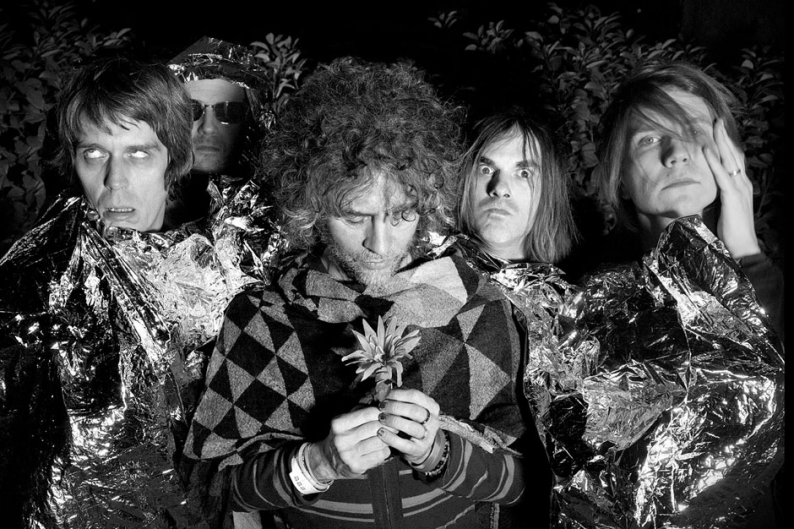The nine grim, harrowing songs that comprise the Flaming Lips thirteenth studio album The Terror are as much a paradigm shift in the Lips’ sound as Zaireeka and The Soft Bulletin before it. Recorded on and off last year at Tarbox Road Studios with longtime co-producer Dave Fridmann in the wee hours between Heady Fwends collaborations, the album finds the Lips favoring heavy-lidded loops and drum machine mesmerism. Traces of Silver Apples, Suicide, Can, Beak>, and Broadcast abound, riding motorik grooves that push everything all deep into Wayne Coyne’s heart of darkness. Or, as he put it from his compound in Oklahoma City, these were songs to be sung “from this despondent futuristic dystopian church.”
To call The Terror the “follow-up” to 2009’s Embryonic is to skip an entire universe of sound the band has spewed forth in the intervening four years. There were re-stagings of Dark Side of the Moon and In the Court of the Crimson King; there was new music embedded in a gummy skull and in a gummy embryo; a song clocking in at six hours and one topping out at 24 hours; a real human skull housing some Lips music. Then there was the string of adventurous EPs showing the band — currently the most viable and sustained major label career in alt-rock — wrestling with young noiseniks like Lightning Bolt and Neon Indian; and Heady Fwends’ jam sessions with Ke$ha, Tame Impala, and Erykah Badu. Coyne and Drozd talk to us about how this freewheeling era informed their latest work.
The Terror hearkens back to the harsh, minimal sounds of early Suicide, Silver Apples, these psychedelic yet repetitious tracks.
Steven Drozd: There’s a song on the new record, “You Lust,” that’s nine or ten minutes long and it’s got this middle section that — for lack of a better term, I’ll call a solo — which is this simple synth riff that just goes for six or seven minutes with these strange vocals on top of it and we just stacked with a bunch of delays so that the voice was always changing. But the riff underneath it was static and exactly the same. If you edited it down to like two minutes, it just wouldn’t have the same effect it does at seven. There’s a mental effect that you get from repetition over time that you can’t get any other way.
Wayne Coyne: During Heady Fwends, we would retreat to Dave Fridmann’s B studio until 2 or 3 a.m. and we’d do this other kind of stuff that was sad, strange music that I guess was good stuff, but we weren’t intending to make another record. We were just dicking around with all this stuff that we were making for the Heady Fwends record. After we had done that a couple of times, we would hear this stuff and go: “Fuck, that sounds cool.” The Terror has this manifesto of: “Don’t think about song lengths, don’t think about marketing, don’t think about anything, just make music that you want to make and get away from this crazy headspace where you fuck it up by fiddling with it.”
Drozd: As a songwriter, you usually write the song and then figure out what the sound should be. But the process for The Terror was we’d find a cool sound: a distorted drum machine or something from a shitty amp or something made on a crazy monosynth that was given to us that other people would think was just a piece of junk. Whatever it was, we’d just record it and catch that sound and then go: “Okay now we’re gonna make a song out of the sound.”
Right before all this work started, you guys curated the 2009 edition of All Tomorrow’s Parties, featuring the nine-drummer iteration of the Boredoms, No Age jamming with Bob Mould, and a ten-hour improv set from Oneida. How much did those ideas of communal music-making, improvisation, and long attention spans carry over to the last few years of the Flaming Lips?
Coyne: Those are great things to point out. You’re totally exactly right. I don’t know if we do this more than other groups, but we are so susceptible to what we’re around.
Drozd: Oh, it certainly affected what we did afterwards. The Oneida thing was — well, I didn’t see all of it, you couldn’t see all of it — but I saw enough at different times as the day went on and witnessed that you really can just have people walk in off the street and participate and influence the way it sounds, but in the end, it still sounds like Oneida. I’m sure it influenced Wayne because that next year and over the next couple of years, we started doing a lot more collaborative work.
Coyne: That’s exactly why you want to collaborate with people, you get another flavor and another smell, another atmosphere, another perspective and you forget yourself and that’s cool, too. That’s why we started doing six-hour songs and 24-hour songs. We thought that was cool and that’s possible to do.
Drozd: When we were recording Embryonic, we had MGMT and Karen O work with us. But after that ATP weekend we “curated,” it seemed like that was a good time to open it up to more collaboration. That festival was a milestone for us, and it changed our way of thinking about the music going forward. Embryonic was really the first time we ever just jammed in the studio and then turned the jams into songs.
Coyne: We were immersed for quite awhile and pretty intensely near the end with the Heady Fwends collaboration. When you talk about the process of anything — making dinner for your family or whether you’re making art or fighting a war — while you’re doing it, you want to have fun. Because it’s all kind of a shitty process that may not lead anywhere. Dinner may suck, you may get shot, the art you make may suck in the end. You live like what you’re doing has to count. I think that’s where this idea comes from where on Monday I’m doing a song with Nick Cave and then Tuesday I’m driving to Nashville to have Ke$ha sing on a song. To me, it’s the shared experiences that are absurd that are great and they have the potential to make great art but part of it is they need to be fun.
What is a day in the life of the Flaming Lips like?
Coyne: Well, we just finished a re-packaging of Zaireeka for Record Store Day. You want to be in the here and now thinking about the future and not the past. Luckily, the Flaming Lips have been around 30 years this year and part of our time is spent constantly and luckily revisiting these older records.
Drozd: Now is a mellow time for the Flaming Lips. For a couple of years there, from 2010 to 2012, the pace was just too much. I got to the point where I was about to lose my mind, we had so many things going on all the time. Touring was just one thing. If we had a week off of tour, we were recording. And if we weren’t doing that, we were traveling from station to station. It started driving me crazy. But now we’re back to where we were before that madness. The record has been finished for a while, but we’re finally back to working on stuff without these hardcore deadlines. And Wayne is always working on something. He spends every day doing some thing, if it’s not music, it’s painting or art or whatever. But for me, I’m just at home with my family laying back.





